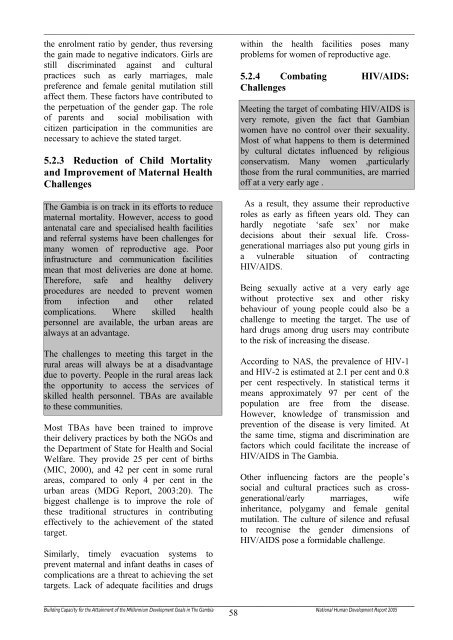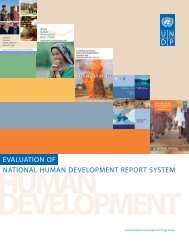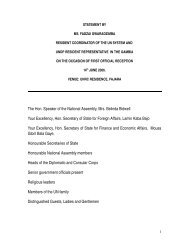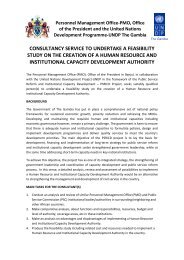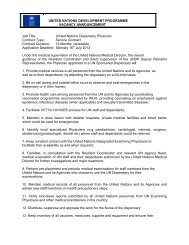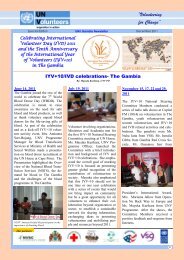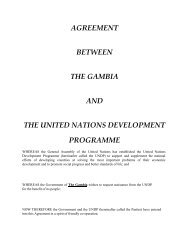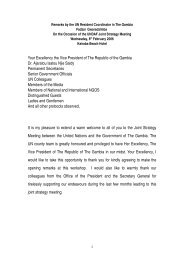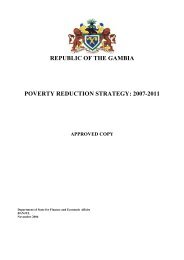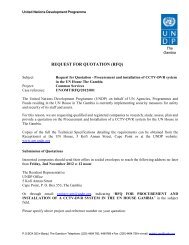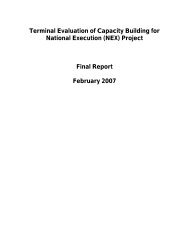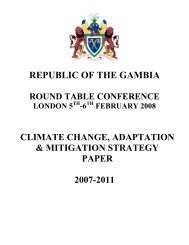Introduction - UNDP The Gambia
Introduction - UNDP The Gambia
Introduction - UNDP The Gambia
Create successful ePaper yourself
Turn your PDF publications into a flip-book with our unique Google optimized e-Paper software.
________________________________________________________________________________________________________________________<br />
the enrolment ratio by gender, thus reversing<br />
the gain made to negative indicators. Girls are<br />
still discriminated against and cultural<br />
practices such as early marriages, male<br />
preference and female genital mutilation still<br />
affect them. <strong>The</strong>se factors have contributed to<br />
the perpetuation of the gender gap. <strong>The</strong> role<br />
of parents and social mobilisation with<br />
citizen participation in the communities are<br />
necessary to achieve the stated target.<br />
5.2.3 Reduction of Child Mortality<br />
and Improvement of Maternal Health<br />
Challenges<br />
within the health facilities poses many<br />
problems for women of reproductive age.<br />
5.2.4 Combating HIV/AIDS:<br />
Challenges<br />
Meeting the target of combating HIV/AIDS is<br />
very remote, given the fact that <strong>Gambia</strong>n<br />
women have no control over their sexuality.<br />
Most of what happens to them is determined<br />
by cultural dictates influenced by religious<br />
conservatism. Many women ,particularly<br />
those from the rural communities, are married<br />
off at a very early age .<br />
<strong>The</strong> <strong>Gambia</strong> is on track in its efforts to reduce<br />
maternal mortality. However, access to good<br />
antenatal care and specialised health facilities<br />
and referral systems have been challenges for<br />
many women of reproductive age. Poor<br />
infrastructure and communication facilities<br />
mean that most deliveries are done at home.<br />
<strong>The</strong>refore, safe and healthy delivery<br />
procedures are needed to prevent women<br />
from infection and other related<br />
complications. Where skilled health<br />
personnel are available, the urban areas are<br />
always at an advantage.<br />
<strong>The</strong> challenges to meeting this target in the<br />
rural areas will always be at a disadvantage<br />
due to poverty. People in the rural areas lack<br />
the opportunity to access the services of<br />
skilled health personnel. TBAs are available<br />
to these communities.<br />
Most TBAs have been trained to improve<br />
their delivery practices by both the NGOs and<br />
the Department of State for Health and Social<br />
Welfare. <strong>The</strong>y provide 25 per cent of births<br />
(MIC, 2000), and 42 per cent in some rural<br />
areas, compared to only 4 per cent in the<br />
urban areas (MDG Report, 2003:20). <strong>The</strong><br />
biggest challenge is to improve the role of<br />
these traditional structures in contributing<br />
effectively to the achievement of the stated<br />
target.<br />
Similarly, timely evacuation systems to<br />
prevent maternal and infant deaths in cases of<br />
complications are a threat to achieving the set<br />
targets. Lack of adequate facilities and drugs<br />
As a result, they assume their reproductive<br />
roles as early as fifteen years old. <strong>The</strong>y can<br />
hardly negotiate ‘safe sex’ nor make<br />
decisions about their sexual life. Crossgenerational<br />
marriages also put young girls in<br />
a vulnerable situation of contracting<br />
HIV/AIDS.<br />
Being sexually active at a very early age<br />
without protective sex and other risky<br />
behaviour of young people could also be a<br />
challenge to meeting the target. <strong>The</strong> use of<br />
hard drugs among drug users may contribute<br />
to the risk of increasing the disease.<br />
According to NAS, the prevalence of HIV-1<br />
and HIV-2 is estimated at 2.1 per cent and 0.8<br />
per cent respectively. In statistical terms it<br />
means approximately 97 per cent of the<br />
population are free from the disease.<br />
However, knowledge of transmission and<br />
prevention of the disease is very limited. At<br />
the same time, stigma and discrimination are<br />
factors which could facilitate the increase of<br />
HIV/AIDS in <strong>The</strong> <strong>Gambia</strong>.<br />
Other influencing factors are the people’s<br />
social and cultural practices such as crossgenerational/early<br />
marriages, wife<br />
inheritance, polygamy and female genital<br />
mutilation. <strong>The</strong> culture of silence and refusal<br />
to recognise the gender dimensions of<br />
HIV/AIDS pose a formidable challenge.<br />
________________________________________________________________________________________________<br />
Building Capacity for the Attainment of the Millennium Development Goals in <strong>The</strong> <strong>Gambia</strong> National Human Development Report 2005<br />
58


